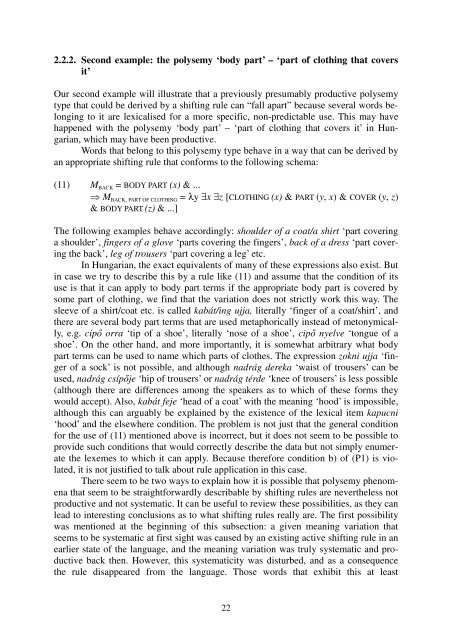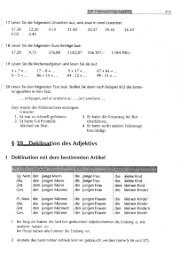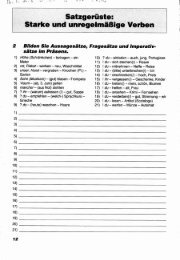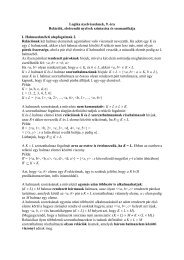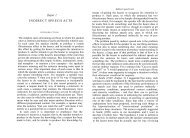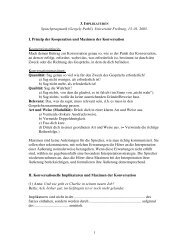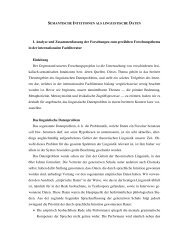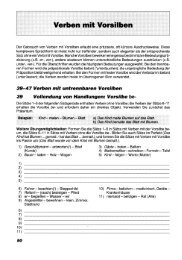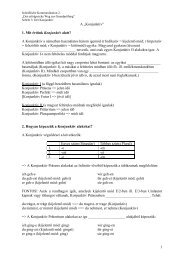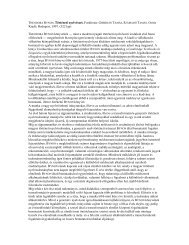On irregular polysemy* Gergely Pethő
On irregular polysemy* Gergely Pethő
On irregular polysemy* Gergely Pethő
Create successful ePaper yourself
Turn your PDF publications into a flip-book with our unique Google optimized e-Paper software.
2.2.2. Second example: the polysemy ‘body part’ – ‘part of clothing that covers<br />
it’<br />
Our second example will illustrate that a previously presumably productive polysemy<br />
type that could be derived by a shifting rule can “fall apart” because several words belonging<br />
to it are lexicalised for a more specific, non-predictable use. This may have<br />
happened with the polysemy ‘body part’ – ‘part of clothing that covers it’ in Hungarian,<br />
which may have been productive.<br />
Words that belong to this polysemy type behave in a way that can be derived by<br />
an appropriate shifting rule that conforms to the following schema:<br />
(11) M BACK = BODY PART (x) & ...<br />
⇒ M BACK, PART OF CLOTHING = λy ∃x ∃z [CLOTHING (x) & PART (y, x) & COVER (y, z)<br />
& BODY PART (z) & ...]<br />
The following examples behave accordingly: shoulder of a coat/a shirt ‘part covering<br />
a shoulder’, fingers of a glove ‘parts covering the fingers’, back of a dress ‘part covering<br />
the back’, leg of trousers ‘part covering a leg’ etc.<br />
In Hungarian, the exact equivalents of many of these expressions also exist. But<br />
in case we try to describe this by a rule like (11) and assume that the condition of its<br />
use is that it can apply to body part terms if the appropriate body part is covered by<br />
some part of clothing, we find that the variation does not strictly work this way. The<br />
sleeve of a shirt/coat etc. is called kabát/ing ujja, literally ‘finger of a coat/shirt’, and<br />
there are several body part terms that are used metaphorically instead of metonymically,<br />
e.g. cipő orra ‘tip of a shoe’, literally ‘nose of a shoe’, cipő nyelve ‘tongue of a<br />
shoe’. <strong>On</strong> the other hand, and more importantly, it is somewhat arbitrary what body<br />
part terms can be used to name which parts of clothes. The expression zokni ujja ‘finger<br />
of a sock’ is not possible, and although nadrág dereka ‘waist of trousers’ can be<br />
used, nadrág csípője ‘hip of trousers’ or nadrág térde ‘knee of trousers’ is less possible<br />
(although there are differences among the speakers as to which of these forms they<br />
would accept). Also, kabát feje ‘head of a coat’ with the meaning ‘hood’ is impossible,<br />
although this can arguably be explained by the existence of the lexical item kapucni<br />
‘hood’ and the elsewhere condition. The problem is not just that the general condition<br />
for the use of (11) mentioned above is incorrect, but it does not seem to be possible to<br />
provide such conditions that would correctly describe the data but not simply enumerate<br />
the lexemes to which it can apply. Because therefore condition b) of (P1) is violated,<br />
it is not justified to talk about rule application in this case.<br />
There seem to be two ways to explain how it is possible that polysemy phenomena<br />
that seem to be straightforwardly describable by shifting rules are nevertheless not<br />
productive and not systematic. It can be useful to review these possibilities, as they can<br />
lead to interesting conclusions as to what shifting rules really are. The first possibility<br />
was mentioned at the beginning of this subsection: a given meaning variation that<br />
seems to be systematic at first sight was caused by an existing active shifting rule in an<br />
earlier state of the language, and the meaning variation was truly systematic and productive<br />
back then. However, this systematicity was disturbed, and as a consequence<br />
the rule disappeared from the language. Those words that exhibit this at least<br />
22


